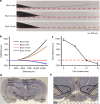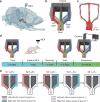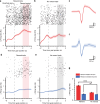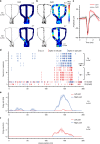Neuronal activity in the ventral tegmental area during goal-directed navigation recorded by low-curvature microelectrode arrays
- PMID: 39396959
- PMCID: PMC11471829
- DOI: 10.1038/s41378-024-00778-2
Neuronal activity in the ventral tegmental area during goal-directed navigation recorded by low-curvature microelectrode arrays
Abstract
Navigating toward destinations with rewards is a common behavior among animals. The ventral tegmental area (VTA) has been shown to be responsible for reward coding and reward cue learning, and its response to other variables, such as kinematics, has also been increasingly studied. These findings suggest a potential relationship between animal navigation behavior and VTA activity. However, the deep location and small volume of the VTA pose significant challenges to the precision of electrode implantation, increasing the uncertainty of measurement results during animal navigation and thus limiting research on the role of the VTA in goal-directed navigation. To address this gap, we innovatively designed and fabricated low-curvature microelectrode arrays (MEAs) via a novel backside dry etching technique to release residual stress. Histological verification confirmed that low-curvature MEAs indeed improved electrode implantation precision. These low-curvature MEAs were subsequently implanted into the VTA of the rats to observe their electrophysiological activity in a freely chosen modified T-maze. The results of the behavioral experiments revealed that the rats could quickly learn the reward probability corresponding to the left and right paths and that VTA neurons were deeply involved in goal-directed navigation. Compared with those in no-reward trials, VTA neurons in reward trials presented a significantly greater firing rate and larger local field potential (LFP) amplitude during the reward-consuming period. Notably, we discovered place fields mapped by VTA neurons, which disappeared or were reconstructed with changes in the path-outcome relationship. These results provide new insights into the VTA and its role in goal-directed navigation. Our designed and fabricated low-curvature microelectrode arrays can serve as a new device for precise deep brain implantation in the future.
© 2024. The Author(s).
Conflict of interest statement
Xinxia Cai is an editor for the journal, no other author has reported any competing interest.
Figures






Similar articles
-
Neurons of the Ventral Tegmental Area Encode Individual Differences in Motivational "Wanting" for Reward Cues.J Neurosci. 2020 Nov 11;40(46):8951-8963. doi: 10.1523/JNEUROSCI.2947-19.2020. Epub 2020 Oct 12. J Neurosci. 2020. PMID: 33046552 Free PMC article.
-
Tonic or Phasic Stimulation of Dopaminergic Projections to Prefrontal Cortex Causes Mice to Maintain or Deviate from Previously Learned Behavioral Strategies.J Neurosci. 2017 Aug 30;37(35):8315-8329. doi: 10.1523/JNEUROSCI.1221-17.2017. Epub 2017 Jul 24. J Neurosci. 2017. PMID: 28739583 Free PMC article.
-
Ventral tegmental area and substantia nigra neural correlates of spatial learning.Learn Mem. 2011 Mar 29;18(4):260-71. doi: 10.1101/lm.1895211. Print 2011 Apr. Learn Mem. 2011. PMID: 21447624
-
VTA GABA Neurons at the Interface of Stress and Reward.Front Neural Circuits. 2019 Dec 5;13:78. doi: 10.3389/fncir.2019.00078. eCollection 2019. Front Neural Circuits. 2019. PMID: 31866835 Free PMC article. Review.
-
Dopamine and reward seeking: the role of ventral tegmental area.Rev Neurosci. 2014;25(5):621-30. doi: 10.1515/revneuro-2014-0019. Rev Neurosci. 2014. PMID: 24887956 Review.
Cited by
-
High-precision neural information detection of multiple brain regions in mice under different concentrations of isoflurane anesthesia based on microelectrode arrays.Microsyst Nanoeng. 2025 Jun 10;11(1):119. doi: 10.1038/s41378-025-00944-0. Microsyst Nanoeng. 2025. PMID: 40494854 Free PMC article.
References
-
- Nyberg, N., Duvelle, E., Barry, C. & Spiers, H. J. Spatial goal coding in the hippocampal formation. Neuron110, 394–422 (2022). - PubMed
LinkOut - more resources
Full Text Sources
Miscellaneous
